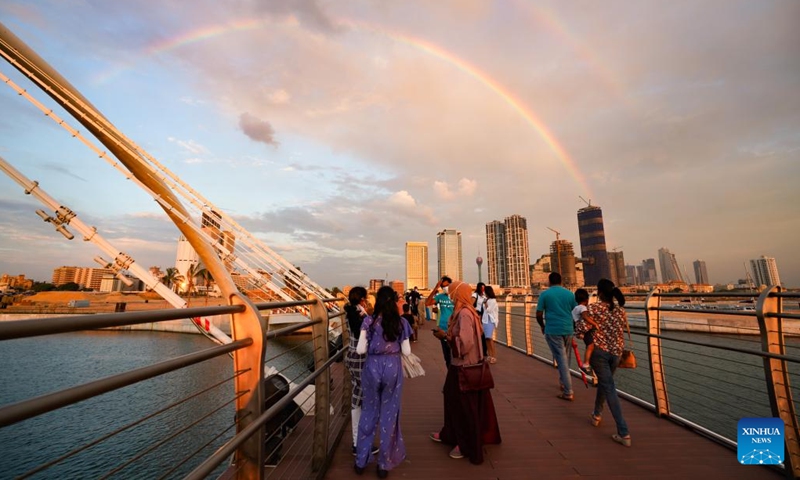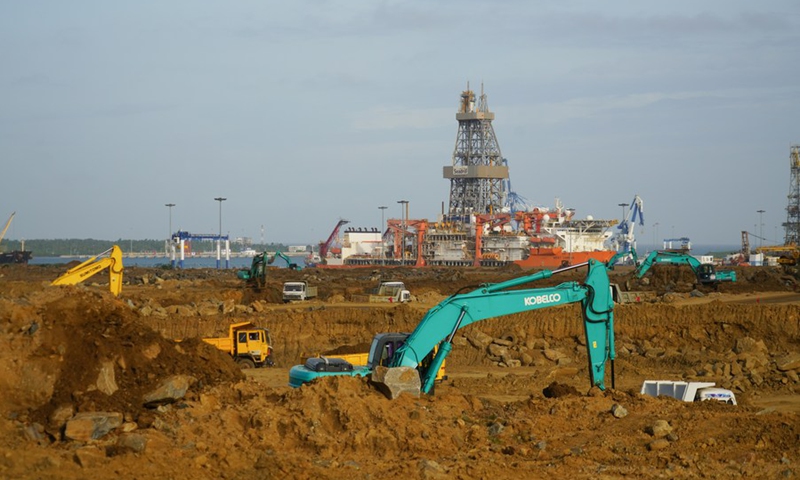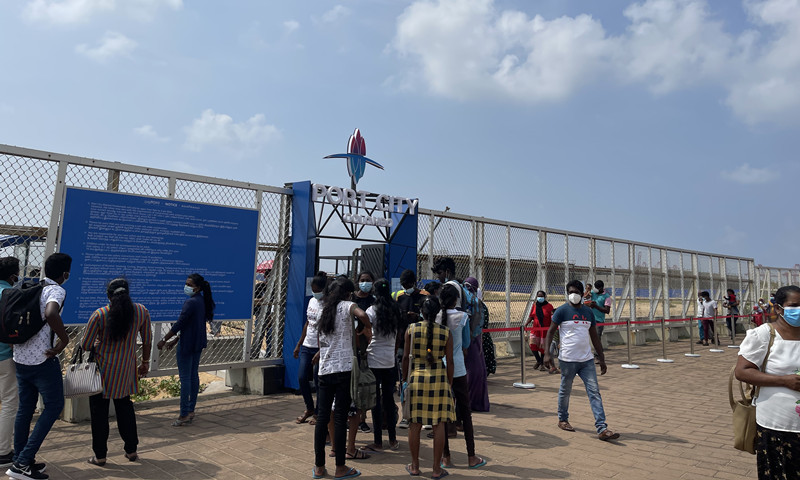
Photo taken on Jan. 10, 2022 shows tourists viewing the scenery at the Marina in Colombo's Port City, Sri Lanka. (Photo: Xinhua)
After Sri Lanka declared an economic emergency and asked China for help at the beginning of the year, some Western and Indian conspiracists once again went on a bashing spree against China and its Belt and Road Initiative (BRI).
By maliciously tying Sri Lanka's recent financial distress to the Chinese investment in the country, they got busy hyping the so-called "Chinese debt trap" in an attempt to mislead the public and attack the China-Sri Lanka cooperation.
Deliberately fabricated rumors were spread in Western and South Asian countries when the President of Sri Lanka, Gotabaya Rajapaksa, reportedly asked China to help restructure the repayment of the country's debt during a meeting with Chinese State Councilor and Foreign Minister, Wang Yi, on January 9.
On that day, some users started creating and spreading rumors on social media that "China's central bank issued bank notes with a face value of 10,000 rupees in Sri Lanka," which was later refuted. This misinformation insinuates China's violation of Sri Lanka's currency sovereignty, smearing the mutually beneficial economic cooperation between the two sides as an "unequal plunder" by China, observers told the Global Times.
With either rumors about currency sovereignty or the so-called "China debt trap," some Western countries, led by the US, and India have been attacking China's overseas construction projects. However, their clichés have rarely been echoed in BRI countries, Chinese and Sri Lankan scholars told the Global Times.
China is a good friend "with consistent economic policies, good trade practices and a win-win attitude," Samitha Hettige, advisor of the National Education Commission of Sri Lanka, mentioned in his article published in December on Sri Lanka's English-language newspaper, Ceylon Today.
"Sri Lanka-China relations are quite strong, only based on friendship and nothing to do with [business or politics]," Hettige told the Global Times.
Disinformation campaign
The rumor about currency sovereignty went rife earlier this month, coinciding with Wang's visit to Sri Lanka. One of the earliest rumormongers was a Twitter user under the name bandhini fernando who frequently posts anti-China misinformation, the Global Times found. On January 9, bandhini fernando posted two fake pictures of "Sri Lanka's new 10,000 rupees note" saying it was issued by the People's Bank of China.
"Wang Yi officially handed over new currency to Sri Lanka during his meeting with [Sri Lankan] President," bandhini fernando wrote. The user claimed that the "new bank note" can be used in Sri Lanka and wickedly described the Chinese-invested projects of
Colombo Port City and Hambantota Port as "Chinese territory."
The rumor was refuted the following day by Sri Lankan fact-checking agency Factcrescendo, which quoted a response by the Deputy Governor of the Central Bank of Sri Lanka, CJP Siriwardana, saying that the bank currently has no plans to issue a 10,000 rupees bank note and the highest currency value in Sri Lanka remains 5,000 rupees.
This is not the first time that gossips like the Sri Lankan bank notes issued by China spread online. In April 2021, another picture of "China-issued 10,000 rupee" was widely shared on social media, which was soon proved false by Factcrescendo. International Law and finance experts consider that the rumors were created to smear China by saying it "violates Sri Lanka's sovereignty," as an independent country with monetary sovereignty will never ask a foreign country's central bank to issue currency on its territory.
The "China debt trap," an old accusation though, is another defamation campaign by the West and India against China-Sri Lanka's economic cooperation. Days before and after Wang met Sri Lankan president in Colombo, media outlets from the US, the UK and India were frequently attacking China with the "China debt trap" or similar eye-catching headlines.
"China's lending comes under fire as Sri Lankan debt crisis deepens," said a misleading headline on article by the Wall Street Journal published on January 18, attributing Sri Lanka's economic crisis to "expensive" and "unprofitable" Chinese investment.
The Chinese Ministry of Foreign Affairs responded saying that the accusations are not true. "China-Sri Lanka cooperation is mutually beneficial and has been warmly welcomed by all sectors in Sri Lanka," said the ministry spokesperson, Wang Wenbin, on January 10.
There is no such thing as a "China debt trap," noted Hettige. "The total Chinese loans only account for a little more than 10 percent of our total loan property portfolio, and China is actually the fourth largest [creditor], behind international capital markets, multilateral development banks and Japan," he told the Global Times, highlighting that "the media did not show the fact."

Photo taken on Aug. 9, 2021 shows the construction site of a tyre factory at the Hambantota Port industrial park in Sri Lanka. (Photo: Xinhua)
US and India behind
The US and India play a major role in the slandering campaign against China-Sri Lanka cooperation and China-funded projects in the country, observers found.
"Sri Lanka has not fallen into a debt trap," president Rajapaksa once stressed in the presence of then US Secretary of State Mike Pompeo, as Sri Lanka's news site Ada Derana reported in October 2020. Readers often see mainstream American newspapers and magazines, including The New York Times, the Wall Street Journal, Foreign Policy and The Atlantic, publish articles blathering about the alleged "China debt trap."
US media are also keen on creating tension as if China has "violated Sri Lanka's sovereignty" or "used economic coercion against Sri Lanka." For instance, a widely spread article from the New York Times titled
How China got Sri Lanka to cough up a port, published in June 2018, described the China-funded Hambantota Port development project as an example of "China's ambitious use of loans and aid to gain influence around the world," and "its willingness to play hardball to collect debt."
Responding to the smears and attacks, Rajapaksa said in an official statement in October 2020 that "constructing a port in Hambantota is an idea of Sri Lanka and not China's." He also added that the project has a vast potential for generating income and employment opportunities for his country.
"The US frequently defames China-invested projects in Sri Lanka, partly to hope that Sri Lanka will abandon [the BRI] and opt for the [aid plans] the US offers," said Qian Feng, Director of the Research Department of the National Strategy Institute at Tsinghua University.
"Either the 'Indo-Pacific strategy' in the Trump era, or the 'new Indo-Pacific economic framework' that the Biden administration is developing, the US is eager to engage more in the South Asian region," Qian said, adding that "so far, they have just shouted slogans and offered little effective financial assistance."
In India, some politicians and media outlets babble much about the Chinese projects in Sri Lanka. Throughout 2021 news outlets like the Times of India and The Hindu and Indian Express have been meddling in China's energy projects in Sri Lanka with groundless accusations of "security concerns".
"The Sri Lankan project is small, supplying electricity to villages on three small islands,"
sources told the Global Times in December 2021, adding that since the islands and the mainland of Sri Lanka are separated by the sea, it is very likely that the power grid will not be connected to other places in the country.
"Some Indian government officials and reporters always regard South Asia as India's 'sphere of influence,' wary of the so-called 'outside forces' developing relations with other countries in the region," Qian said while highlighting that "with hostility toward China, they see China's cooperation with countries like Sri Lanka a weakening of India's power of influence there."

Local residents visit the newly-opened marina of Colombo's Port City on January 23, 2022. Photo: Chen Runze
Truth speaks for itself
Nonetheless, the anti-China noises made by countries like the US and India only represent a very small group in the region, Qian noted. "No matter if it is in Sri Lanka, or other South Asian countries like Nepal and Bangladesh, they are and will always be far from the mainstream."
"China has a long history of cooperation with many South Asian countries and its assistance is not limited to the BRI," Qian said, adding that "China has a good reputation among people of these countries." He also mentioned that "people there can see and feel the development opportunities and improved living standards that China has brought them. They will not get blinded by the slander and sabotage from India and some Western countries."
In a village in northern Sri Lanka, local residents said they enjoy more development opportunities and convenient lives thanks to the roads that Chinese enterprises helped build there.
"I'm very grateful to China," Kumar, a local resident who owned a grocery store, told to the Global Times in November 2021. "The roads built by Chinese companies have helped improve my business as more people have come to the village [because of better traffic conditions]," Kumar said, remarking that his income quadrupled and was planning to open a small restaurant.
This year marks the 65th anniversary of the establishment of diplomatic ties between China and Sri Lanka and the 70th anniversary of the signing of the
Rubber-Rice Pact. Official documents show that through decades of mutual help and win-win cooperation, China has become one of Sri Lanka's biggest sources of foreign investment and trading partners.
The Colombo Port City project, for instance, will attract additional investment up to $12.7 billion over the next 20 years, and is expected to add $13.8 billion to the Sri Lankan economy once fully operational, according to a study released by PricewaterhouseCoopers (PwC) late last year. The project will be "the main income generator for the future of Sri Lanka," creating 83,000 direct jobs and many more indirect job opportunities for Sri Lankans, said president Rajapaksa in September 2020.
"South Asia needs China in its development because China is synonymous of 'development,'" according to an article published on January 17 by Sri Lankan English-language media outlet Daily News. China's BRI "provides benefits for almost all South Asian countries, …[and] has proved already that it is a well-wisher and friend of South Asia," noted the article titled
Sri Lanka, Bangladesh and Nepal Need China for Development.






